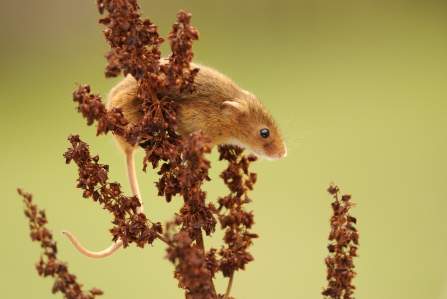Harvest mice are not especially fussy, they are happy anywhere there are ample stems for them to clamber up, very rarely descending to the ground if they can avoid it. They are tiny, around 6cm long, with a tail close to the same length. The tail is used to help with balance and climbing. They react quickly to disturbance, disappearing back into the vegetation in response to nearby noises.
Harvest mice are thought to be fairly widespread but are very difficult to find. Their presence is mostly picked up by the signs they leave behind - their intricate nests. The nests are carefully woven from grass and leaves within dense vegetation, at least 10cm above ground, so even these are difficult to spot! Harvest mice adapted to farmed habitats by creating their nests in crop fields such as wheat and barley, but modern combine harvesters have caused a new threat. When fields were hand-cut, the mice could easily run to the safety of field margins, but modern machinery does not give them the time to escape. They also build their nests and live in verges, reedbeds and grassy hedges. These habitats have been lost in many areas as green spaces are developed and wetlands drained.
Recent studies have helped shine a light on this elusive mammal, but more must be done to protect the harvest mouse. They seem to be able to respond quickly to changes in habitat, as long as the habitat is connected to others and buffer zones are present between developments and their living space. Reintroductions can work well, as the mice are relatively easy to breed, and once conservation efforts are in place they seem to breed and colonise the reintroduction area quickly. The more we learn about marginal habitats like road verges and field edges , the more they are shown to be important for all sorts of wildlife, including our smallest rodent.


